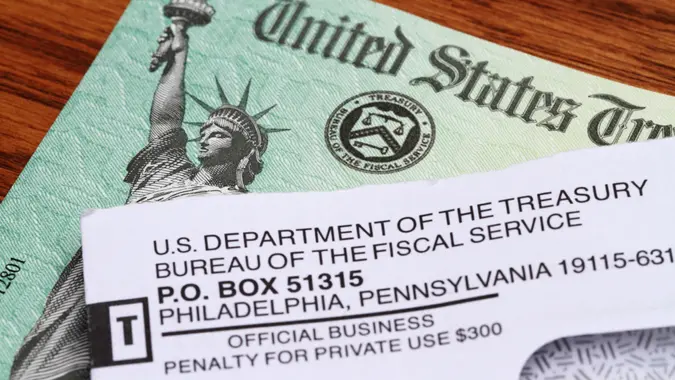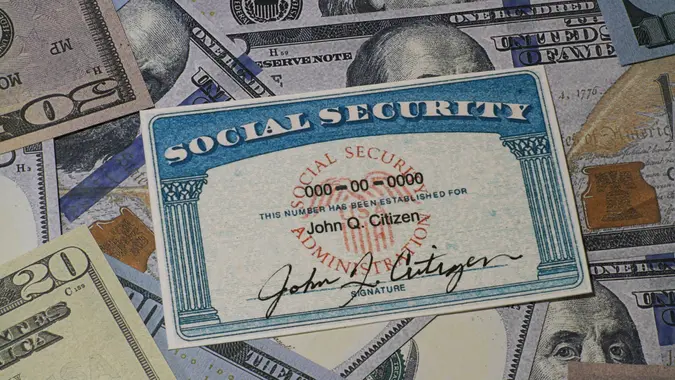Are You Breaking One of Social Security’s 2,728 Rules?

Commitment to Our Readers
GOBankingRates' editorial team is committed to bringing you unbiased reviews and information. We use data-driven methodologies to evaluate financial products and services - our reviews and ratings are not influenced by advertisers. You can read more about our editorial guidelines and our products and services review methodology.

20 Years
Helping You Live Richer

Reviewed
by Experts

Trusted by
Millions of Readers
Given the often-complicated nature of government programs, you might not be surprised to learn that the Social Security system has thousands of rules to follow. In a column last decade for PBS, author and Boston University economics professor Laurence Kotlikoff calculated that theSocial Security Handbook had 2,728 separate rules governing just its benefits. That figure might have gone up since then.
While there is no pressing need to learn all of these rules, there are some you want to make sure you don’t break to maximize your Social Security benefits. In some cases the rules you want to follow are more like guidelines to ensure you take full advantage of the program.
However, breaking some rules will result in penalties. For example, you can be penalized for making “false or misleading statements or withholding information” about certain benefits and claims, according to the Social Security Administration.
The penalties in this case are nonpayment of benefits that the SSA would otherwise pay you as well as ineligibility for cash benefits. The duration of the penalty varies according to these rules:
- Six consecutive months the first time the SSA penalizes you
- 12 consecutive months the second time it penalizes you
- 24 consecutive months the third or subsequent time it penalizes you
Breaking other rules won’t necessarily result in penalties imposed by the SSA but can still lead to a smaller monthly payment.
One of Social Security’s most important rules governs when you can collect retirement benefits. You can claim them as early as age 62. However, you won’t get all the money you are due until full retirement age, which is either 66 or 67, depending on your birth date.
The longer you wait to collect Social Security, the higher your benefit. You will get the biggest monthly payment by claiming at age 70, after which there is no advantage to waiting.
Another rule to keep in mind is that your retirement benefits are based on average indexed monthly earnings on up to 35 full working years. The highest-earning 35 years are used in the calculation. If you work the full 35 years, you can maximize your Social Security check. If you work less than 35 years, your benefit won’t be as much — regardless of how much you earned during your career.
The minimum earnings record to qualify for Social Security benefits is at least 10 years of work, or 40 credits. If you try to break this rule by applying for benefits with less than 40 credits, you’ll be ruled ineligible.
Some Social Security recipients have second thoughts about claiming benefits after they have already started collecting them. The rule to keep in mind here is sometimes referred to as “start stop start.” You can stop and restart benefits as long as you are in your first year of collecting retirement benefits, according to AARP. In this case, you can apply to Social Security for a “withdrawal of benefits.”
You might seek a withdrawal if you filed for Social Security at age 62 because you needed the money, then received an unexpected financial windfall such as a high-paying job offer or inheritance. As AARP noted, you are now in position where you can afford to wait until you are older to claim benefits to ensure a larger monthly payment.
The SSA lets you withdraw your original application for retirement benefits only one time — and you must do so within 12 months of the date you first claimed your benefits. You start the process by filling out Social Security form SSA-521 and then sending the completed form to your local Social Security office.
If you try to withdraw your original application after receiving benefits for more than a year, you are breaking the rule and will be denied the withdrawal. The best option now is to wait until you reach full retirement age and request a suspension of benefits. With this option, you can accrue delayed retirement credits, which will increase your monthly retirement benefit when you start collecting again, according to AARP.
More From GOBankingRates
- Nearly 1 in 3 Americans Hit by a Costly Holiday Scam, Norton Survey Shows -- How To Avoid This
- Here's What the Average Social Security Payment Will Be in Winter 2025
- How Middle-Class Earners Are Quietly Becoming Millionaires -- and How You Can, Too
- The Easiest Way to Score $250 for Things You Already Do
 Written by
Written by  Edited by
Edited by 

























